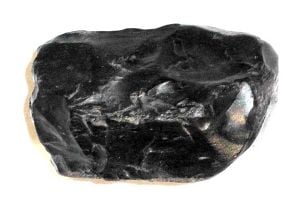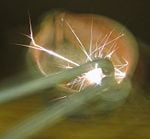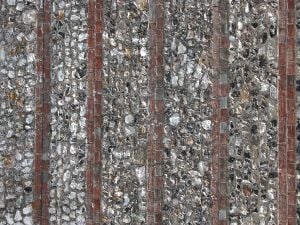Difference between revisions of "Flint" - New World Encyclopedia
m (Unlink unwanted links) |
|||
| (28 intermediate revisions by 4 users not shown) | |||
| Line 1: | Line 1: | ||
| − | {{ | + | ê{{Images OK}}{{Approved}}{{copyedited}} |
| − | {{ | + | :''This article is about the sedimentary rock.'' |
| − | [[Image:Flint.jpg|thumb | + | [[Image:Flint.jpg|thumb|A flint nodule from the [[Onondaga (geological formation)|Onondaga]] limestone layer, [[Buffalo, New York]]. (3.8 cm wide)]] |
| − | |||
| − | |||
| − | |||
| − | |||
| − | |||
| − | |||
| − | |||
| − | |||
| − | |||
| − | |||
| − | |||
| − | |||
| − | |||
| − | The exact mode of formation of flint is not yet clear | + | '''Flint''' (or '''flintstone''') is a hard, [[sedimentary rock|sedimentary]], [[cryptocrystalline]] form of the [[mineral]] [[quartz]], categorized as a variety of [[chert]]. It occurs chiefly as [[Nodule (geology)|nodule]]s and masses in sedimentary rocks, such as [[chalk]]s and [[limestone]]s. Inside the nodule, flint is usually dark gray, black, green, white, or brown in color, and often has a glassy or waxy appearance. A thin layer on the outside of the nodules is usually different in color, typically white, and rough in texture. From a [[petrology|petrological]] point of view, "flint" refers specifically to the form of chert that occurs in chalk or marly limestone. Similarly, "common chert" (sometimes referred to simply as "chert") occurs in limestone. |
| + | {{toc}} | ||
| + | In early history, flint was used for making cutting [[tool]]s and igniting [[fire]]. In addition, it has been used as a material for the construction of houses, churches, and other structures. It has also been used in the preparation of [[ceramic]]s. | ||
| + | [[Image:flintbeach.jpg|thumb|upright|Pebble beach made up of flint nodules eroded out of the nearby [[chalk]] cliffs, [[Cape Arkona]], [[Rügen]].]] | ||
| + | [[Image:Feuersteinaxt.jpg|thumb|Late [[Stone Age]] flint axe, about 31 cm long.]] | ||
| + | [[Image:Flint spark lighter striking.jpg|thumb|150px|Modern [[flint spark lighter]] being struck.]] | ||
| + | [[Image:Flint Wall Wiltshire.JPG|thumb|Detail of flint used in a building in Wiltshire, England.]] | ||
| + | == Formation == | ||
| + | As noted above, flint is a form of quartz,<ref>Web Mineral, [http://webmineral.com/data/Quartz.shtml Quartz,] Webmineral.com. Retrieved November 25, 2008.</ref><ref>The Quartz Page, [http://www.quartzpage.de/flint.html Flint and Chert.] Retrieved November 25, 2008.</ref> found as masses associated with [[chalk]] and [[limestone]].<ref name=Flints>BBM, [http://www.bbm.me.uk/portsdown/PH_320_Flint.htm The Flints from Portsdown Hill]. Retrieved November 25, 2008.</ref><ref>Authentic Artifacts Collectors Association, [http://www.theaaca.com/Learning_Center/flintvs.htm Flint vs Chert: What's the Difference?] Retrieved November 25, 2008.</ref> However, the exact mode of formation of flint is not yet clear. It is currently thought that flint is formed as a result of chemical changes in compressed sedimentary rock formations, during the process of [[diagenesis]]. One [[hypothesis]] is that a gelatinous material fills cavities in the sediment, such as holes bored by [[crustaceans]] or [[molluscs]] and that this becomes [[silicification|silicified]]. This theory is able to explain the complex shapes of flint nodules that are found. The source of dissolved silica in the porous media could arise from the spicules of siliceous sponges.<ref name=Flints/> | ||
== Uses == | == Uses == | ||
| − | ===Tools=== | + | ===Tools or cutting edges=== |
| + | Flint was used for the manufacture of flint tools during the [[Stone Age]], as it splits into thin, sharp splinters called flakes or blades (depending on the shape) when struck by another hard object (such as a [[hammerstone]] made of another material). This process is referred to as [[knapping]]. | ||
| − | Flint | + | In [[Europe]], some of the best toolmaking flint has come from [[Belgium]] (Obourg, flint mines of [[Spiennes]]),<ref>Neolithic Flint Mines of Petit-Spiennes, The Spiennes Site.</ref> the coastal chalks of the [[English Channel]], the [[Paris Basin (geology)|Paris Basin]], [[Thy (district)|Thy]] in [[Jutland]] (flint mine at Hov), the Sennonian deposits of [[Rügen]], [[Grimes Graves]] in England and the [[Jurassic]] deposits of the [[Kraków]] area in [[Poland]]. Flint mining is attested since the [[Paleolithic]], but became more common since the [[Neolithic]] (Michelsberg culture, [[Funnelbeaker culture]]). |
| − | + | ===To ignite fire or gunpowder=== | |
| + | When struck against [[steel]], a flint edge will produce sparks of steel. The hard flint edge shaves off a particle of the steel that, heated by the friction, burns with [[oxygen]] from the atmosphere and can ignite the proper [[tinder]]. This method is popular in woodcraft, bushcraft, and among others who wish to use traditional skills. | ||
| − | + | Striking sparks with flint and steel is not particularly easy or convenient method to start a [[fire]], although it is much easier than other primitive fire-making methods such as using a [[bow drill]]. As with most skills, practice improves results. By comparison, [[matches]] and [[cigarette lighters]] are a much quicker and more convenient way of starting a fire. | |
| − | |||
| − | A later major use was | + | A later, major use of flint and steel was the [[flintlock]], primarily used on firearms (but also used on dedicated fire-starting tools). A piece of flint held in the jaws of a spring-loaded hammer, when released by a trigger, strikes a [[hinged]] piece of steel ("[[frizzen]]") at an angle, creating a shower of sparks and exposing a charge of priming powder. The sparks ignite the priming powder and that flame, in turn, ignites the main charge propelling the ball, bullet, or shot in the barrel. While the military use of the flintlock declined after the adoption of the [[percussion cap]] from the 1840s onward, the flintlock is still popular on hunting rifles and shotguns used in the United States. |
| − | === | + | Use of flint and steel should not be confused with use of [[ferrocerium]] (also called "[[hot spark]]," "[[metal match]]," or "[[fire steel]]"). This human-made material, when scraped with any hard, sharp edge, produces sparks that are much hotter than obtained with natural flint and steel, allowing use of a wider range of tinder. Because it can produce sparks when wet and can start hundreds or thousands of fires when used correctly, ferrocerium is a common item included in survival kits. Called "flint," ferrocerium is also used in many cigarette lighters. |
| − | Flint | + | |
| + | ===As a building material=== | ||
| + | [[Image:flint church in england arp.jpg|thumb|left|upright|A flint [[Church (building)|church]]—the Parish Church of Saint Thomas, in [[Cricket Saint Thomas]], [[Somerset]], [[England]]. The height of the very neatly knapped flints varies between 3 and 5 inches (8-13 cm).]] | ||
| + | |||
| + | Flint, knapped or unknapped, has been used since antiquity (for example at the Late Roman fort of [[Gariannonum|Burgh Castle]] in [[Norfolk]]) up to the present day as a material for building stone walls, using lime mortar, and often combined with other available stone or brick rubble. It was most common in parts of southern [[England]], where no good building stone was available locally, and [[brick]]-making not widespread until the later Middle Ages. It is especially associated with [[East Anglia]], but also used in chalky areas stretching through [[Sussex]], [[Surrey]] and [[Kent]] to [[Somerset]]. Flint was used in the construction of many churches, houses, and other buildings, for example the large stronghold of [[Framlingham Castle]]. Many different decorative effects have been achieved by using different types of knapping or arrangement and combinations with stone ([[flushwork]]), especially in the fifteenth and early sixteenth centuries. | ||
===Ceramics=== | ===Ceramics=== | ||
| − | Flint pebbles are used as the media in ball mills to grind glazes and other raw materials for the ceramics industry. The pebbles are hand-selected for | + | Flint pebbles are used as the media in ball mills to grind glazes and other raw materials for the ceramics industry. The pebbles are hand-selected for color, with those showing a reddish tint, indicating the presence of [[iron]], being discarded. The remaining blue-gray stones have a low content of [[chromophoric]] oxides and so should impart lesser amounts of coloring contaminants. |
| − | In the UK, flint pebbles were traditionally an important raw material for clay-based [[ceramic]] bodies | + | In the UK, flint pebbles were traditionally an important raw material for clay-based [[ceramic]] bodies. After [[calcination]] to remove organic impurities and induce certain physical reactions, and milling to fine particle size, flint was added as a filler to [[pottery]] bodies. However, flint is no longer used and has been replaced by quartz as is used in other countries.<ref>A. Sugden, Changes & Developments Of Non-plastic Raw Materials, ''International Ceramics'' 2 (2001).</ref> Because of this historical use, the word "flint" is used by U.S. potters to refer to siliceous materials that are not flint.<ref>C.W. Parmelee, ''Ceramic Glazes,'' 3rd ed. (The Maple Press Company, 1973).</ref><ref>A. Dodd, ''Dictionary of Ceramics,'' 3rd ed. (The Institute of Materials, 1994).</ref><ref>F. Hamer and J. Hamer, ''The Potter's Dictionary of Materials and Techniques'' (London: A & C Black, 2004).</ref> |
| + | |||
| + | <gallery> | ||
| + | Image:2004 melford trinity church 02.JPG|Elaborate fifteenth-century flint and [[limestone]] flushwork at [[Long Melford]]. | ||
| + | Image:Surroundings of Canterbury Cathedral 02.JPG|A typical medieval wall (with modern memorial) at [[Canterbury Cathedral]]—knapped and unknapped ("cobble") flints are mixed with pieces of brick and other stones. | ||
| + | Image:2004 thetford 03.JPG|Ruins of [[Thetford]] Priory show flints and mortar through the whole depth of the wall. | ||
| + | Image:Ethelbert Gate, to Norwich Cathedral.jpg|Elaborate patterned flushwork at top (restored in the nineteenth century) and flint and limestone chequers below. [[Norwich Cathedral]]. | ||
| + | </gallery> | ||
==See also== | ==See also== | ||
| − | + | * [[Obsidian]] | |
| − | *[[ | + | * [[Quartz]] |
| − | *[[ | + | * [[Rock (geology)]] |
| − | *[[ | + | * [[Sedimentary rock]] |
| + | * [[Silica]] | ||
| + | |||
| + | == Notes == | ||
| + | <references/> | ||
| + | |||
| + | ==References== | ||
| + | * Dixon, Dougal. ''The Practical Geologist.'' New York: Simon and Schuster, 1992. ISBN 0671746979. | ||
| + | * Farndon, John. ''The Practical Encyclopedia of Rocks & Minerals: How to Find, Identify, Collect and Maintain the World's best Specimens, with over 1000 Photographs and Artworks''. London: Lorenz Books, 2006. ISBN 0754815412. | ||
| + | * Pellant, Chris. ''Rocks and Minerals.'' Smithsonian Handbooks. New York: Dorling Kindersley, 2002. ISBN 0789491060. | ||
| + | * Pough, Frederick H., and Roger Tory Peterson. ''Peterson First Guide to Rocks and Minerals.'' Boston: Houghton Mifflin, 1991. ISBN 0395935431. | ||
| + | * Shaffer, Paul R., Herbert S. Zim, and Raymond Perlman. ''Rocks, Gems and Minerals''. Rev. ed. New York: St. Martin's Press, 2001. ISBN 1582381321. | ||
==External links== | ==External links== | ||
| + | All links retrieved April 13, 2017. | ||
| + | * [http://www.flintsource.net/ FlintSource.net]. | ||
| + | * [http://www.gilesdelamare.co.uk/page3.htm Flint Architecture of East Anglia]. Book by Stephen Hart. | ||
| − | + | ---- | |
| − | + | {{Silica minerals}} | |
| − | + | [[Category:Physical sciences]] | |
| − | + | [[Category:Earth sciences]] | |
| + | [[Category:Geology]] | ||
| − | + | {{credit|250191731}} | |
| − | |||
| − | {{ | ||
Revision as of 19:13, 9 November 2023
ê
- This article is about the sedimentary rock.
Flint (or flintstone) is a hard, sedimentary, cryptocrystalline form of the mineral quartz, categorized as a variety of chert. It occurs chiefly as nodules and masses in sedimentary rocks, such as chalks and limestones. Inside the nodule, flint is usually dark gray, black, green, white, or brown in color, and often has a glassy or waxy appearance. A thin layer on the outside of the nodules is usually different in color, typically white, and rough in texture. From a petrological point of view, "flint" refers specifically to the form of chert that occurs in chalk or marly limestone. Similarly, "common chert" (sometimes referred to simply as "chert") occurs in limestone.
In early history, flint was used for making cutting tools and igniting fire. In addition, it has been used as a material for the construction of houses, churches, and other structures. It has also been used in the preparation of ceramics.
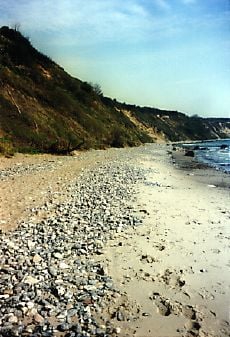

Formation
As noted above, flint is a form of quartz,[1][2] found as masses associated with chalk and limestone.[3][4] However, the exact mode of formation of flint is not yet clear. It is currently thought that flint is formed as a result of chemical changes in compressed sedimentary rock formations, during the process of diagenesis. One hypothesis is that a gelatinous material fills cavities in the sediment, such as holes bored by crustaceans or molluscs and that this becomes silicified. This theory is able to explain the complex shapes of flint nodules that are found. The source of dissolved silica in the porous media could arise from the spicules of siliceous sponges.[3]
Uses
Tools or cutting edges
Flint was used for the manufacture of flint tools during the Stone Age, as it splits into thin, sharp splinters called flakes or blades (depending on the shape) when struck by another hard object (such as a hammerstone made of another material). This process is referred to as knapping.
In Europe, some of the best toolmaking flint has come from Belgium (Obourg, flint mines of Spiennes),[5] the coastal chalks of the English Channel, the Paris Basin, Thy in Jutland (flint mine at Hov), the Sennonian deposits of Rügen, Grimes Graves in England and the Jurassic deposits of the Kraków area in Poland. Flint mining is attested since the Paleolithic, but became more common since the Neolithic (Michelsberg culture, Funnelbeaker culture).
To ignite fire or gunpowder
When struck against steel, a flint edge will produce sparks of steel. The hard flint edge shaves off a particle of the steel that, heated by the friction, burns with oxygen from the atmosphere and can ignite the proper tinder. This method is popular in woodcraft, bushcraft, and among others who wish to use traditional skills.
Striking sparks with flint and steel is not particularly easy or convenient method to start a fire, although it is much easier than other primitive fire-making methods such as using a bow drill. As with most skills, practice improves results. By comparison, matches and cigarette lighters are a much quicker and more convenient way of starting a fire.
A later, major use of flint and steel was the flintlock, primarily used on firearms (but also used on dedicated fire-starting tools). A piece of flint held in the jaws of a spring-loaded hammer, when released by a trigger, strikes a hinged piece of steel ("frizzen") at an angle, creating a shower of sparks and exposing a charge of priming powder. The sparks ignite the priming powder and that flame, in turn, ignites the main charge propelling the ball, bullet, or shot in the barrel. While the military use of the flintlock declined after the adoption of the percussion cap from the 1840s onward, the flintlock is still popular on hunting rifles and shotguns used in the United States.
Use of flint and steel should not be confused with use of ferrocerium (also called "hot spark," "metal match," or "fire steel"). This human-made material, when scraped with any hard, sharp edge, produces sparks that are much hotter than obtained with natural flint and steel, allowing use of a wider range of tinder. Because it can produce sparks when wet and can start hundreds or thousands of fires when used correctly, ferrocerium is a common item included in survival kits. Called "flint," ferrocerium is also used in many cigarette lighters.
As a building material
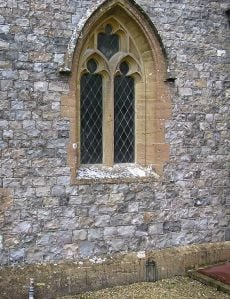
Flint, knapped or unknapped, has been used since antiquity (for example at the Late Roman fort of Burgh Castle in Norfolk) up to the present day as a material for building stone walls, using lime mortar, and often combined with other available stone or brick rubble. It was most common in parts of southern England, where no good building stone was available locally, and brick-making not widespread until the later Middle Ages. It is especially associated with East Anglia, but also used in chalky areas stretching through Sussex, Surrey and Kent to Somerset. Flint was used in the construction of many churches, houses, and other buildings, for example the large stronghold of Framlingham Castle. Many different decorative effects have been achieved by using different types of knapping or arrangement and combinations with stone (flushwork), especially in the fifteenth and early sixteenth centuries.
Ceramics
Flint pebbles are used as the media in ball mills to grind glazes and other raw materials for the ceramics industry. The pebbles are hand-selected for color, with those showing a reddish tint, indicating the presence of iron, being discarded. The remaining blue-gray stones have a low content of chromophoric oxides and so should impart lesser amounts of coloring contaminants.
In the UK, flint pebbles were traditionally an important raw material for clay-based ceramic bodies. After calcination to remove organic impurities and induce certain physical reactions, and milling to fine particle size, flint was added as a filler to pottery bodies. However, flint is no longer used and has been replaced by quartz as is used in other countries.[6] Because of this historical use, the word "flint" is used by U.S. potters to refer to siliceous materials that are not flint.[7][8][9]
Elaborate fifteenth-century flint and limestone flushwork at Long Melford.
See also
Notes
- ↑ Web Mineral, Quartz, Webmineral.com. Retrieved November 25, 2008.
- ↑ The Quartz Page, Flint and Chert. Retrieved November 25, 2008.
- ↑ 3.0 3.1 BBM, The Flints from Portsdown Hill. Retrieved November 25, 2008.
- ↑ Authentic Artifacts Collectors Association, Flint vs Chert: What's the Difference? Retrieved November 25, 2008.
- ↑ Neolithic Flint Mines of Petit-Spiennes, The Spiennes Site.
- ↑ A. Sugden, Changes & Developments Of Non-plastic Raw Materials, International Ceramics 2 (2001).
- ↑ C.W. Parmelee, Ceramic Glazes, 3rd ed. (The Maple Press Company, 1973).
- ↑ A. Dodd, Dictionary of Ceramics, 3rd ed. (The Institute of Materials, 1994).
- ↑ F. Hamer and J. Hamer, The Potter's Dictionary of Materials and Techniques (London: A & C Black, 2004).
ReferencesISBN links support NWE through referral fees
- Dixon, Dougal. The Practical Geologist. New York: Simon and Schuster, 1992. ISBN 0671746979.
- Farndon, John. The Practical Encyclopedia of Rocks & Minerals: How to Find, Identify, Collect and Maintain the World's best Specimens, with over 1000 Photographs and Artworks. London: Lorenz Books, 2006. ISBN 0754815412.
- Pellant, Chris. Rocks and Minerals. Smithsonian Handbooks. New York: Dorling Kindersley, 2002. ISBN 0789491060.
- Pough, Frederick H., and Roger Tory Peterson. Peterson First Guide to Rocks and Minerals. Boston: Houghton Mifflin, 1991. ISBN 0395935431.
- Shaffer, Paul R., Herbert S. Zim, and Raymond Perlman. Rocks, Gems and Minerals. Rev. ed. New York: St. Martin's Press, 2001. ISBN 1582381321.
External links
All links retrieved April 13, 2017.
- FlintSource.net.
- Flint Architecture of East Anglia. Book by Stephen Hart.
| |||||||||||||||||||||||||
Credits
New World Encyclopedia writers and editors rewrote and completed the Wikipedia article in accordance with New World Encyclopedia standards. This article abides by terms of the Creative Commons CC-by-sa 3.0 License (CC-by-sa), which may be used and disseminated with proper attribution. Credit is due under the terms of this license that can reference both the New World Encyclopedia contributors and the selfless volunteer contributors of the Wikimedia Foundation. To cite this article click here for a list of acceptable citing formats.The history of earlier contributions by wikipedians is accessible to researchers here:
The history of this article since it was imported to New World Encyclopedia:
Note: Some restrictions may apply to use of individual images which are separately licensed.
